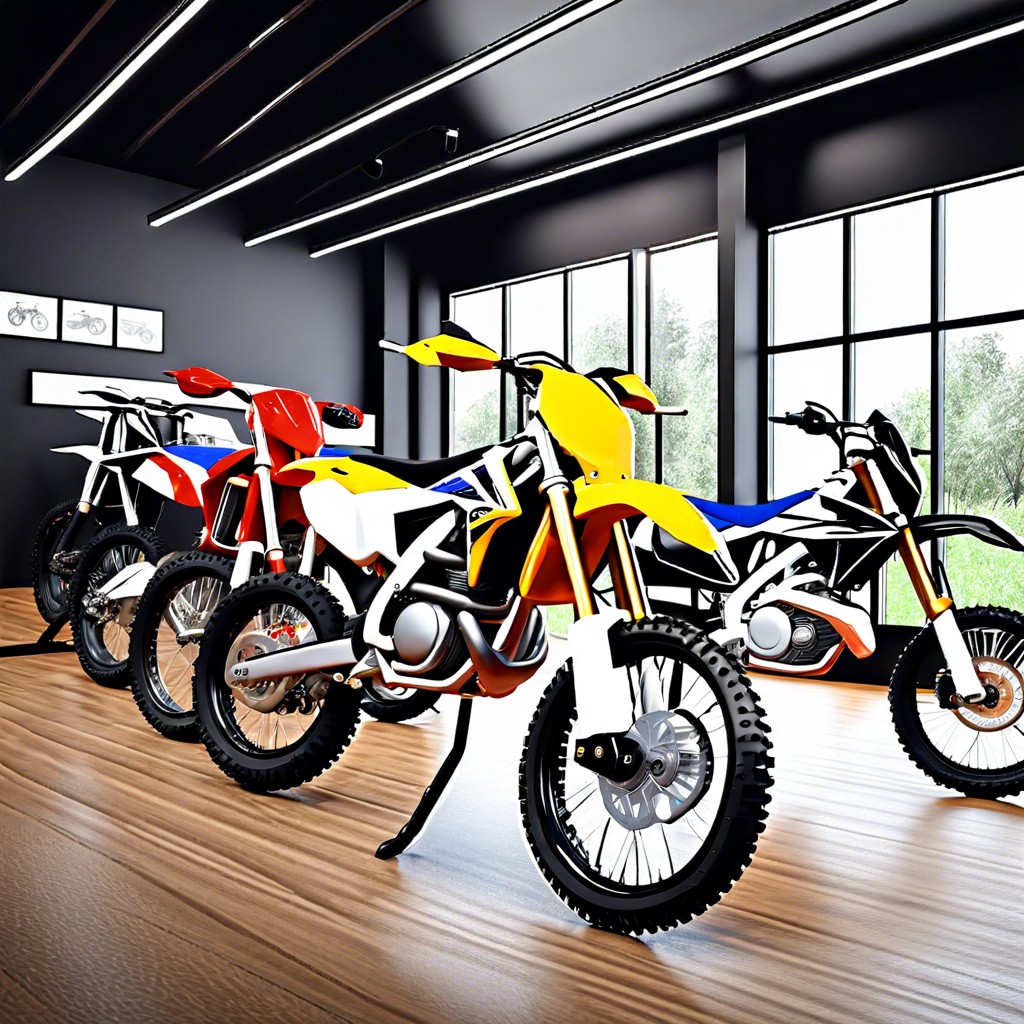Discover the factors that influence the cost of a dirt bike and learn how to select the best option within your budget.
Key takeaways:
- Brand and model affect prices, premium brands cost more.
- Engine size determines power and cost, smaller engines are cheaper.
- New features like suspension and fuel injection increase price.
- Materials like carbon fiber increase cost, steel is cheaper.
- Dealer location and availability affect pricing, limited models cost more.
Factors That Impact Dirt Bike Prices

- Brand and Model:
- Premium brands with a reputation for high performance and durability often command higher prices than lesser-known manufacturers. Specific models that cater to advanced riding or racing capabilities also feature top-tier pricing.
- Engine Size:
- A larger engine typically results in increased power output and higher costs. Smaller engines, suitable for beginners or casual riders, are generally more affordable.
- New Features and Technology:
- Innovations such as advanced suspension systems, electronic fuel injection, or traction control systems can contribute to a higher price point as they promise an enhanced riding experience.
- Materials and Build Quality:
- Dirt bikes constructed with lightweight, high-strength materials like carbon fiber or titanium will be more expensive than those made with standard steel or aluminum frames.
- Dealer Location and Availability:
- Geographical location can affect pricing due to shipping costs, dealership overhead, and local demand. Additionally, limited availability of certain models can raise their market price.
- Maintenance and Upkeep History:
- For used dirt bikes, a well-documented maintenance history with regular servicing can retain value, while bikes with unknown or poor upkeep histories might be priced lower to reflect potential future repair costs.
Buying A Dirt Bike: An Overview
Entering the realm of dirt biking requires a keen understanding of what you’re purchasing and why. Factors such as the brand, model, engine size, and technology define a bike’s price point. Popular brands like Honda and Yamaha offer models that are reliable with a slightly higher cost, whereas less known brands can be more affordable.
Engine size, measured in cubic centimeters (cc), plays a significant role; larger engines typically command higher prices. The advancement in bike technology, including suspension systems and materials, also adds to the cost.
Maintenance history is crucial when considering a second-hand bike. Be mindful of the bike’s condition and any potential repairs needed, as these can add to the overall investment.
Essentially, it’s important to balance your budget with your needs and preferences to find the right bike for you. Keep in mind that additional costs such as gear, maintenance, and potential modifications should also factor into your total budget.
New Vs. Used: Which Is Right for You?
Deciding between a new or used dirt bike hinges on individual needs, preferences, and budget.
New dirt bikes offer the latest technology, performance upgrades, and come with warranties. Ideal for those seeking peace of mind and willing to invest in a pristine machine, the upfront cost is higher but ensures you’re riding a bike with no wear or prior issues.
Conversely, used dirt bikes can be significantly cheaper, making them an attractive option for beginners or riders on a budget. They are also suitable for those looking to customize or who enjoy refurbishing older models. When buying used, it’s crucial to inspect the bike thoroughly and be mindful of potential maintenance costs stemming from wear and tear.
Your choice should align with your riding style, financial situation, and your comfort level with bike maintenance. Serious racers may prefer the cutting-edge features of new models while hobbyists could benefit from the value a used bike offers.
Consider all factors thoroughly to ensure your investment matches your long-term riding goals and capabilities.
Type of Dirt Bikes for Different Riding Styles
Selecting the right type of dirt bike for your preferred riding style is vital for both performance and enjoyment.
Motocross bikes are designed for high jumps and fast turns on groomed tracks, with features such as powerful engines and long suspension travel.
Enduro bikes, on the other hand, are built for off-road conditions requiring durability and versatility, offering a comfortable ride over long distances on varied terrains.
Trail bikes are focused on casual rides, emphasizing user-friendly handling and low maintenance, perfect for beginners and those looking for leisurely forest and mountain rides.
Dual-sport bikes blend on-road legality with off-road capability, equipped with mirrors, lights, and a less aggressive tire tread, suitable for those who commute on weekdays and hit trails on weekends.
Understanding your riding intentions—be it competitive racing or recreational fun—will guide you toward the appropriate class and subsequently influence the cost of your dirt bike.
Exploring Dirt Bike Costs in 2024
Dirt bike prices vary significantly based on several key factors such as brand, engine size, and features. In 2024, entry-level bikes may start around $3,000, attracting new riders who are keen on exploring off-road experiences without a hefty initial investment. These models typically feature smaller engines and fewer high-end components but are robust enough for beginners.
Mid-range dirt bikes offer a balance between performance and cost, generally priced between $5,000 and $8,000. They are equipped with larger engines, better suspension, and more durable frames, suitable for intermediate riders looking to step up their game.
At the premium end, prices can soar above $10,000, targeting experienced riders who demand top-of-the-line performance and innovation. These dirt bikes boast cutting-edge technology, superior materials, and engineering refinements. Brands like KTM and Husqvarna often lead in this category, with their models boasting advanced features like traction control, wireless connectivity, and high-performance powertrains.
It’s crucial for potential buyers to consider not only the purchase price but also ongoing maintenance costs, availability of replacement parts, and potential resale value. Accessories and gear, necessary for safe riding, will also contribute to the overall investment in the sport. Keep in mind that prices fluctuate based on economic factors, dealer location, and time of year.